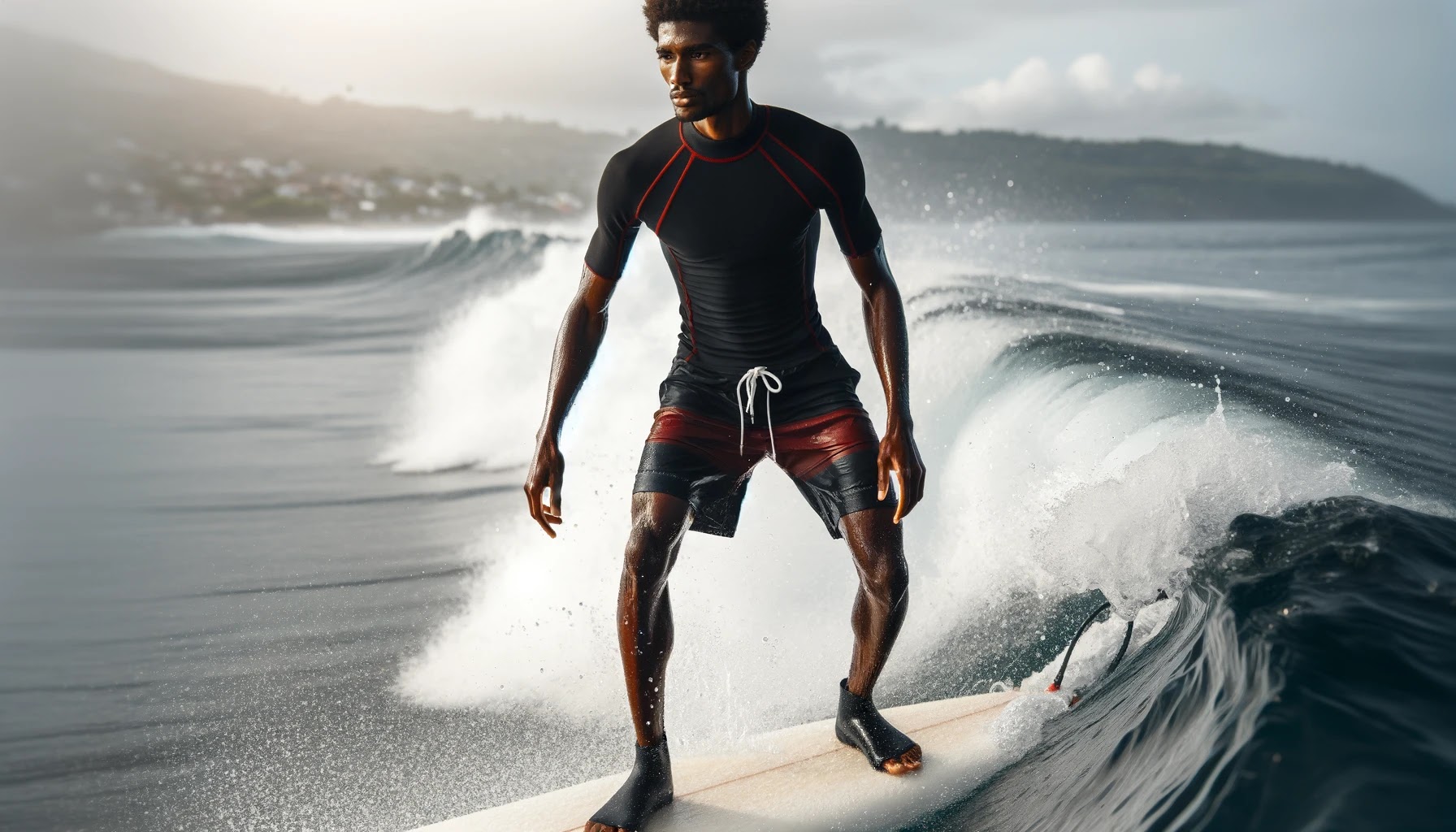As the heat of summer settles in, many of us seek refuge in the cool embrace of the water. The beach, the lake, or the river becomes our second home. While we pack our bathing suits, towels, and sunscreen, there's an often-overlooked piece of gear that can greatly enhance our aquatic escapades: water shoes. A hybrid blend of form and function, water shoes offer a plethora of benefits, ranging from safety to comfort.
Water shoes, often referred to as swim shoes, beach shoes or aqua shoes, are designed specifically for activities where your feet are likely to get wet. Unlike regular shoes, swim shoes have unique features that make them apt for use in and around water.
Constructed with quick-drying, breathable materials, beach shoes not only allow water to drain out but also promote air circulation, keeping your feet dry and comfortable. Moreover, they come with robust soles that provide excellent traction even on wet, slippery surfaces, thereby minimizing the risk of slips and falls.
Furthermore, water shoes’ protective toe guard shields your feet from the harsh realities of the underwater world, such as sharp rocks, broken glass, or unseen aquatic creatures. Their lightweight, compact nature makes them easily packable, a practical choice for various water-based activities.
What is the origin of water shoes?
Navigating the pages of history to find the origin of a particular invention often feels like being on an exciting treasure hunt. One such fascinating pursuit is tracing the evolution of water shoes. From being a practically functional piece of footwear to evolving into a stylish, activity-specific accessory, aqua shoes have come a long way.
The Early History: Utilitarian Beginnings
The concept of shoes designed explicitly for water is not new. In fact, it stretches back to ancient times when different civilizations developed their own forms of footwear to aid their water-related activities.
Take, for instance, the Ainu people of Japan, who had straw boots, or "saranip," as part of their traditional attire. Made from dried straw, these boots were waterproof and were used for traversing wet, marshy areas. Elsewhere, in snowy regions like Siberia and Alaska, indigenous people fashioned waterproof boots from sealskin or other animal hides to keep their feet dry during ice fishing or seal hunting.
While these early examples were far removed from the aqua shoes we know today, they served a similar purpose: to provide protection, traction, and comfort in wet conditions.
The Evolution: From Utility to Specialization
Fast forward to the 20th century, the introduction of new materials and technologies marked a significant turning point in the evolution of swim shoes. With the advent of synthetic materials like rubber and later neoprene, footwear could now be made water-resistant, durable, and more comfortable.
During the 1960s and 70s, as recreational water activities like rafting, kayaking, and sailing gained popularity, the demand for activity-specific footwear grew. It was during this period that beach shoes, as we know them today, began to take shape. They were initially designed as a safety measure for water sports enthusiasts who needed protective footwear that offered grip on slippery boat decks and safeguarded their feet from sharp rocks and other underwater hazards.
Brands like Teva, founded in 1984 by a Grand Canyon river guide, started designing water-friendly sandals. The first Teva sandal, a blend of a flip-flop and a sports shoe, had a treaded sole for grip and a nylon ankle strap for secure fit. This design ignited the development of modern aqua shoes and initiated the shift from utilitarian waterproof footwear to more specialized swim shoes.
Into the 21st Century: Innovation and Diversification
As the new millennium dawned, the aqua shoe market saw considerable diversification. Companies began to offer variations catering to specific activities – kayaking, fishing, hiking through water trails, and even shoes for swimming.
Materials continued to evolve with mesh panels for breathability, quick-drying fabrics, and antimicrobial treatments to combat odors and fungus. The soles were enhanced to offer better grip on wet surfaces, with thermoplastic rubber being a popular choice. The designs also became more user-friendly with easy slip-on styles and bungee cord lacing for a secure fit.
A significant milestone in water shoes innovation was the creation of 'FiveFingers' in 2005 by the Italian company Vibram. Resembling a glove for the foot, each toe was separated to promote natural foot movement. Made with a water-resistant upper and a non-slip sole, it found favor among water sports enthusiasts and marked a major innovation in the design of water shoes.
Current Trends and Future Trajectories
Today, the beach shoe industry continues to expand and innovate. Companies are investing in research and development to make water shoes more efficient, comfortable, and sustainable. Swim shoes now incorporate features like integrated drainage systems to allow water to flow out, adjustable straps for a customized fit, and lightweight construction for better mobility.
Moreover, sustainability has become a focal point, with brands using recycled materials and eco-friendly processes. An exciting future trend is the advent of 3D printed water shoes, which would allow customization like never before, both in terms of fit and design.
Not All Water Shoes Are Created Equal
As with any type of footwear, water shoes come in different styles and designs, catering to different needs and preferences. Here's a rundown of the most common types:
Aqua Socks
Aqua socks, also known as swim shoes, are the lightest and most flexible type of water shoes. Featuring a slip-on design, they offer a snug fit, much like a second skin. Aqua socks are typically made of neoprene, a type of synthetic rubber known for its excellent water and heat insulation properties.
The thin, flexible soles of aqua socks are ideal for protecting the feet from hot sand, pebbles, or small pieces of shell that you might encounter while swimming or lounging by the beach. However, they're not recommended for rough terrains due to their lack of robust foot support and traction.Active Water Shoes
Active water shoes are the aquatic equivalent of your regular trainers. They offer a perfect blend of functionality, comfort, and style, making them an excellent choice for a wide range of water sports such as kayaking, paddle boarding, and sailing.
Made from quick-drying, breathable materials, active water shoes provide ample ventilation and feature a robust sole for superior traction on wet surfaces. They often come with a lace-up system or adjustable straps, ensuring a secure fit even in rushing waters. If you're seeking a versatile water shoe for your next adventure, active water shoes are the way to go.Water Sandals
Water sandals marry the open design of sandals with the functionality of water shoes. Offering an excellent balance between breathability, comfort, and protection, water sandals are a popular choice for many water-based activities.
Waterproof sandals are designed with quick-drying, durable materials, and feature robust soles that provide a strong grip, even on slippery rocks. Plus, their open-toe design offers added breathability, making them ideal for a day of fishing, casual rafting, or just hanging out by the water.Water Hiking Shoes
Navigating a hiking trail that includes rivers, streams, or other wet obstacles calls for the right footwear: water hiking shoes. These shoes offer the sturdiness and ankle support of hiking boots, coupled with the quick-drying feature of water shoes.
Constructed with tough, waterproof materials, water hiking shoes keep your feet dry and comfortable. Their soles are designed for maximum grip on both dry and wet surfaces. Often, they come with a lace-up system that guarantees a snug fit, providing stability even on challenging terrains.Pool Shoes
Pool shoes, designed primarily for use around swimming pools, have gained popularity for their simplicity, comfort, and convenience. Made from water-friendly materials like plastic or rubber, pool shoes protect your feet from the hot poolside surface and prevent slips on wet tiles.
Although not suitable for rough terrains or vigorous water sports, pool shoes are perfect for casual swimming sessions, water aerobics, or showering in communal showers, as they also offer protection against foot infections.
River Shoes
River shoes are engineered to withstand the unique challenges posed by river environments, including slippery rocks, strong currents, and underwater debris. Typically, they are built with a robust structure, quick-drying materials, and offer excellent water drainage.
The soles of river shoes are designed for superior traction on wet, slippery surfaces, ensuring stability and safety while you enjoy river rafting, canoeing, or river trekking. For those regularly engaging in river activities, investing in a sturdy pair of river shoes can significantly enhance safety and comfort.
Surf Shoes
Surf shoes are designed to offer comfort, protection, and superior grip while you catch and ride waves. They protect your feet from potential hazards such as sharp coral, rocks, or marine creatures lurking beneath the waters. Made with neoprene and other quick-drying materials, surf shoes provide thermal protection, preventing your feet from getting chilled in cold water conditions.
The robust soles, often made from rubber, offer excellent traction on the surfboard, allowing you to execute moves with precision and stability. Furthermore, they typically feature a snug fit to prevent them from being swept away by the waves. Whether you're a novice learning to find your balance on the board or a seasoned surfer pushing the limits, surf shoes are a worthwhile investment, ensuring you can ride the waves with confidence and style.What are the benefits of water shoes?
Water shoes offer a plethora of benefits but among the most notable are:
Safety: Your Feet's Best Defense
The foremost benefit of water shoes is the superior safety they offer. Whether you're walking on a beach strewn with sharp shells, navigating slippery rocks in a river, or exploring a seabed with hidden dangers, water resistant shoes provide invaluable protection. They safeguard your feet from cuts, scrapes, puncture wounds, and abrasion that you may encounter in aquatic environments. For those with specific medical conditions like diabetes, where even a small foot injury can lead to significant complications, wet shoes serve as a crucial protective barrier.
Comfort: Keeping Pace with Your Adventures
Beyond safety, water shoes excel in providing comfort. They are typically lightweight and use flexible, quick-drying materials, ensuring that your feet stay cozy and dry. The breathability of water proof shoes also helps in reducing foot fatigue, thereby enabling you to enjoy your water activities for extended periods. Many models feature padded insoles and arch support to provide additional comfort and minimize strain on your feet.
Traction: Securing Every Step
Another standout benefit of water shoes is their superior traction on wet and slippery surfaces. These shoes are designed with soles made from rubber or other synthetic materials that grip well on slick rocks, boat decks, or wet trails, preventing slips and falls. This level of traction is especially critical when participating in water sports such as kayaking, canoeing, or paddleboarding, where a steady foothold is key to balancing and controlling your movements.
Versatility: One Shoe, Multiple Uses
Water resistant shoes shine in their versatility. These shoes are not just for swimming or beachcombing; they can transition from water to land seamlessly, making them perfect for hiking wet trails, camping near water bodies, or partaking in water sports. They are also apt for poolside use, water aerobics, and even communal showers, making them a great companion for your gym or spa visits. With wet shoes, you get multiple types of footwear rolled into one.
Thermal Protection: An Unseen Barrier
Water shoes also offer thermal protection, a benefit that is particularly important in cold water environments. Activities like snorkeling, diving, or swimming in cold waters can expose your feet to the risk of hypothermia. Water resistant shoes, particularly those made from neoprene, provide excellent insulation, helping to keep your feet warm and preventing thermal shock.
Healthy Feet: Preventing Infections and Promoting Hygiene
Wearing aqua shoes can help prevent various infections. Communal showers, pool areas, or natural water bodies can be breeding grounds for bacteria and fungi, leading to athlete's foot, plantar warts, or other foot infections. Swim shoes serve as a barrier, protecting your feet from direct contact with these surfaces. Additionally, some water shoes come with anti-microbial treatments that inhibit the growth of bacteria and fungi, promoting foot hygiene and health.
Fashion Forward: Adding Style to Functionality
Last but not least, water shoes don’t fall short in the style department. Gone are the days when beach shoes were clunky and unattractive. Modern aqua shoes come in a plethora of designs, colors, and patterns, combining functionality with fashion. Whether you prefer a sporty look or a more casual style, there’s a water shoe out there that matches your aesthetic preferences. So, while these shoes protect your feet, they also let you make a style statement.
The Versatility of Water Shoes for Every Occasion
The utility of water shoes extends far beyond the confines of the beach or swimming pool. These shoes blend protective features and comfort, making them ideal for a wide array of settings and occasions:
Beach Holidays
Your idyllic beach vacation can turn sour quickly if you step on a sharp seashell or a piece of broken glass. Water shoes offer crucial protection against such mishaps. Whether you're enjoying a leisurely stroll along the shoreline, playing beach volleyball, or exploring a rocky cove, bech shoes ensure your feet remain safe and comfortable. They also provide an excellent grip on wet sand and rocks, reducing the risk of slips and falls.
Water Sports
Water sports enthusiasts will attest to the value of a good pair of water shoes. Whether you're into kayaking, paddleboarding, sailing, or white-water rafting, swim shoes can enhance your performance by offering superior traction, ensuring stability and balance. They protect your feet from any underwater hazards and provide thermal insulation in colder waters. For surfers, specialized surf shoes can offer added grip on the board, enabling better control and maneuverability.
Hiking and Camping
If your trail involves crossing streams or walking along slippery rocks, water shoes can prove to be a boon. They provide the sturdiness of hiking boots while also delivering the quick-drying features of water shoes. Their rugged soles provide excellent traction on both wet and dry surfaces, making them a reliable companion for your adventurous outings.
Poolside and Water Aerobics
For activities that revolve around a swimming pool, like a pool party or water aerobics, water shoes are a perfect fit. They protect your feet from hot concrete surfaces, prevent slips on wet tiles, and guard against foot infections commonly found in communal pool areas. For water aerobics, where exercises require grip and balance, pool shoes can significantly enhance safety and performance.
Fishing and Boating
When fishing or boating, you need shoes that can handle the slippery deck and protect your feet from sharp hooks or other tools. Water shoes, with their superior grip and durability, are an excellent choice. Furthermore, if you need to step into the water to push off your boat or wade through a stream, water resistant shoes will keep your feet dry and secure.
Snorkeling and Diving
While flippers are typically worn for these activities, water shoes can offer additional protection and comfort, especially when walking on the beach with heavy gear. For snorkeling, in particular, swim shoes provide a buffer against sharp corals or sea creatures, ensuring your underwater exploration is safe and enjoyable.
Community Showers and Locker Rooms
Public showers and locker rooms at gyms, spas, or sports facilities can harbor various bacteria and fungi, leading to foot infections. Water shoes act as a protective barrier, shielding your feet from direct contact with these surfaces. They also provide the added benefit of preventing slips on wet floors.
Amusement Parks and Water Parks
Amusement parks often have water rides where shoes can get wet, and water parks necessitate footwear that can handle the aquatic environment. Aqua shoes can transition seamlessly from dry to wet conditions, offering comfort, safety, and quick-drying convenience.
Gardening
While this may seem surprising, water shoes are indeed a great fit for gardening. They are easy to clean, provide excellent grip, and their quick-drying feature makes them suitable for tasks like watering plants or washing the patio.
Navigating the Shopping Seas: Buying the Right Water Shoes
The broad range of water shoes in the market can make the buying process daunting:
Understand Your Needs
Before you can dive into the vast sea of aqua shoes, you need to first determine why you need them. Are they for casual beach wear? For water sports? Or perhaps for a hiking adventure that will have you crossing streams and navigating slippery rocks? The context in which you'll be using your swim shoes will determine the type of shoe you need.
For instance, if you're going to participate in rigorous water sports like surfing or kayaking, you might want surf shoes with a robust design, offering excellent grip and ankle support. On the other hand, if they're for casual beach use, you may opt for lightweight, comfortable shoes that are easy to slip on and off.
Check the Material
Water shoes are typically made from a variety of materials, each with their own pros and cons. Most are designed to be quick-drying to prevent the discomfort of wet shoes.
For instance, swim shoes with a neoprene upper provide a snug fit and keep your feet warm in cooler waters, making them ideal for activities like snorkeling or paddleboarding. Mesh aqua shoes, on the other hand, offer superior breathability and dry quickly, making them suitable for hiking in wet conditions or for beach wear.
The sole material also plays a critical role. Rubber soles are commonly used due to their superior grip on slippery surfaces and durability.
Consider the Design
There's a range of design options to consider when buying water shoes. For instance, do you want a slip-on design for easy wear, or would you prefer something with adjustable straps or laces for a more secure fit?
Also, consider whether you need a closed or open-toe design. Closed-toe water resistant shoes offer more protection, making them ideal for rocky terrains, while open-toe designs offer more breathability.
Ensure a Good Fit
Just like any other shoes, beach shoes need to fit well. Shoes that are too loose may come off, especially when in the water. On the other hand, shoes that are too tight can cause discomfort and blisters.
Keep in mind that swim shoes are designed to fit snugly, but they should not be constricting. Your toes should have some wiggle room, and there should be no pinching at the sides.
Don't Forget About Traction
One of the main purposes of water shoes is to provide traction on wet and slippery surfaces. The soles of the shoes should have a substantial grip to prevent slipping during water activities.
Look for aqua shoes with thick rubber soles and deep treads, as these typically offer the best traction. Some water shoes also have a 'sticky' gum rubber bottom to provide superior grip on wet rocks.
Assess Durability
Water shoes are designed to withstand harsh conditions, such as rocky terrains, salt water, and sun exposure. To ensure that your shoes will last, look for water sandals with a sturdy construction and high-quality materials.
Check the stitching and ensure that it's strong and secure. The material should also be resilient enough to withstand wear and tear. Some aqua shoes offer added durability features, such as reinforced toes for extra protection.
Price and Value
The cost of water shoes can vary widely, depending on the brand, materials used, and design features. While it's important to stay within your budget, it's equally crucial to ensure that you're getting good value for your money.
It may be worth paying a bit more for a pair of beach shoes that offer high-quality materials and construction, comfort, excellent traction, and a design that suits your needs. Remember, a well-made pair of water shoes can last you for several seasons, providing excellent value over time.









0 Comments